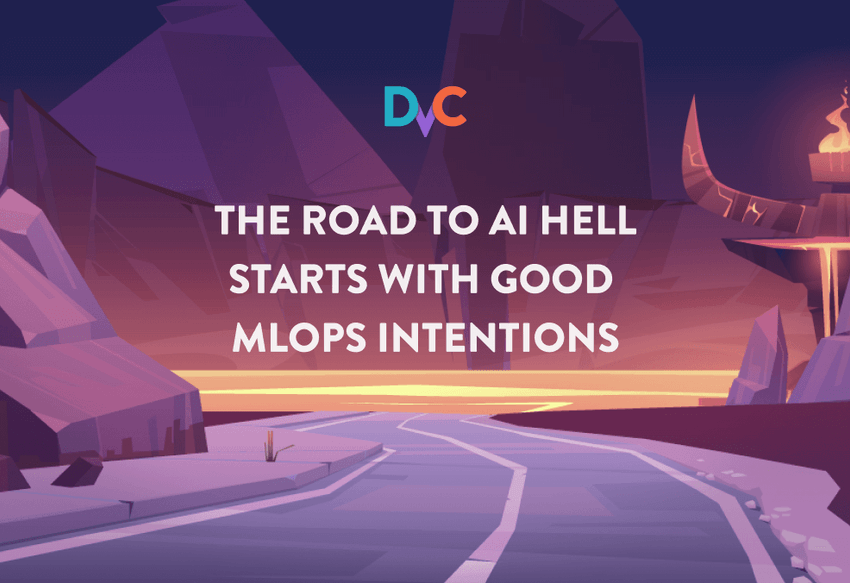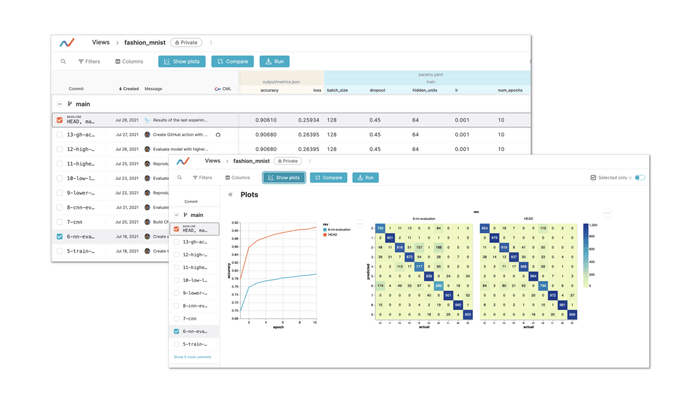The Road to Hell Starts with Good MLOps Intentions
Our philosophy on how ML and AI should be developed. Why we believe extending the best practices of software engineering to the machine learning space will ultimately be the most effective solution for MLOps.

Let's avoid hell, shall we?
Machine learning operations (MLOps) in the last year has emerged as a distinct IT discipline for building machine learning (ML) or artificial intelligence (AI) models. While at first blush that may seem like a viable method for automating the building of AI models, in reality purveyors of MLOps platforms have a vested interest in convincing organizations to acquire platforms that exist outside of best DevOps practices that have already been proven to accelerate application development.
AI models, however, are ultimately a software artifact like any other that needs to be integrated within an application. The trouble with MLOps as it is most often pursued today is data scientists are constructing AI models in almost complete isolation from the rest of the organization. The hope is that somehow when the AI model is completed it will magically be incorporated into an application development workflow. Unfortunately for all concerned, the rate at which applications are being developed using best DevOps practices rarely align with the rate at which AI models are being constructed.
"The trouble with MLOps as it is most often pursued today is data scientists are constructing AI models in almost complete isolation from the rest of the organization."
The result is not only a lot of wasted time and effort, the rate at which digital business transformation initiatives that depend on AI models are rolled out becomes a significant competitive disadvantage. In effect, the road to AI hell is paved with good MLOps intentions.
While working as a data scientist at Microsoft, I saw firsthand how machine learning and AI was traditionally implemented in an isolated fashion. That unsatisfactory experience led to the launch of opensource Data Version Control (DVC) and Continuous Machine Learning (CML) tools that integrate ML workflows into best practices for software development. Instead of creating a separate proprietary AI platform that needs to be acquired and maintained, the goal needs to be to extend traditional software tools such as Git, collaboration and continuous integration/continuous delivery (CI/CD) platforms to meet the needs of both developers and ML engineers. The entire ML stack needs to be reinvented in a way that makes it accessible to every developer.
DVC and CML are open source tools, that now along with DVC Studio, streamline the workflow of data scientists. They integrate ML workflows into current practices for software development in a way that eliminates the need for many features of proprietary AI platforms such as AWS SageMaker, Microsoft Azure ML and Google Vertex AI by extending traditional software tools like Git and CI/CD platforms to meet the needs of ML researchers and ML engineers. In essence, they provide an open platform based on best DevOps practices to operationalize ML and AI.
"DVC and CML are open source tools that streamline the workflow of data scientists. They integrate ML workflows into current practices for software development in a way that eliminates the need for many features of proprietary AI platforms such as AWS SageMaker, Microsoft Azure ML and Google Vertex AI by extending traditional software tools like Git and CI/CD platforms to meet the needs of ML researchers and ML engineers."
MLOps is about operations and automation for ML and AI. It covers the entire lifecycle of an ML process including labeling data, development, modeling, and monitoring. Every ML/AI platform offers this functionality. However, our vision for MLOps is different. We think it should be embedded within your DevOps processes. It should be part of your engineering infrastructure, engineering stack and engineering processes. ML requires additional tools. It’s just those tools need to be incorporated into a larger toolchain.
The primary reason to do this is to interact more consistently with people from the software engineering side and to reuse proven tools such as Git, GitHub/GitLab and CI/CD systems. An ML silo that builds an AI model outside the traditional application development process creates a divide that needs to be bridged whenever a data scientist needs to collaborate with engineers. For example, with a traditional AI platform, all the workflows are predefined. There may be some opportunity to modify them, but for all intents and purposes, those workflows are inflexible. That’s the wrong approach. Teams made up of data scientists and developers should be able to define their own workflow based on their business requirements and team preferences, just like they do today when constructing any other software artifact. Rather than a platform forcing teams to embrace a highly opinionated workflow, they can employ flexible tools such Git, GitHub, and their existing CI tools as they see fit.
"Teams made up of data scientists and developers should be able to define their own workflow based on their business requirements and team preferences, just like they today when constructing any other software artifact."
How We Do It
When it comes to software engineering, everything in a workflow is based on the version of the artifact. However, when working with large data sets, that approach doesn’t work because there is no data versioning with existing tools. We extend existing DevOps tools so that developers can version code in addition to ML models.
In addition to allowing for data and modeling versioning, we also align data scientists to the CI/CD process. This enables the data scientist to share code and data with other members of the team in a way that actually works on their machines! That’s critical because code is typically run through a third-party platform to determine if it will run in a production environment. There is no way to bring data into this process, which means there’s no real way to determine whether a model works before deploying it. There are no ways to show metrics. There are no ways to compare your metrics with your production metrics. In this scenario, everything needs to be instrumented to attach required plots to test. That takes a lot of time. We enable multiple plot points to be tested. Finally, we provide a place to visualize and analyze data other than employing Microsoft Excel spreadsheets. We extend traditional software engineering functionality by providing a better system to visualize data right on top of your GitHub, GitLab or BitBucket user interface.
"We believe an open source-based workflow based on version control and CI tools will streamline machine learning in the same way software development has already been modernized."
Conclusion
We believe an open source-based workflow based on version control and CI tools will streamline machine learning in the same way software development has already been modernized. If data scientists, engineers and developers can accelerate the development of ML/AI models by reusing files, pipelines, experiments and even entire models stored in a Git repository, the rate at which AI will be infused into software will increase by several orders of magnitude and, best of all, the road to AI hell is not taken.
This post originally appeared in The New Stack.

